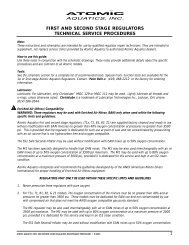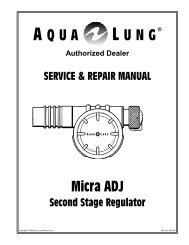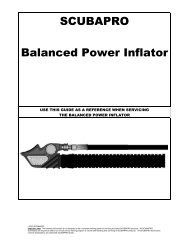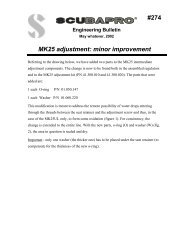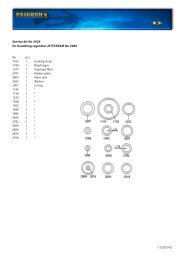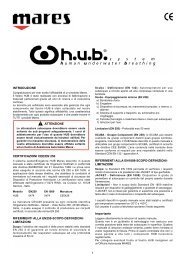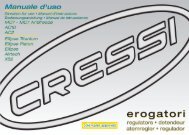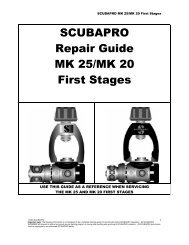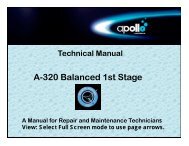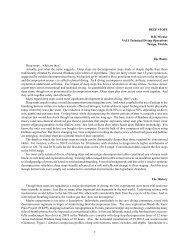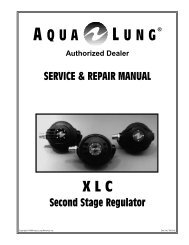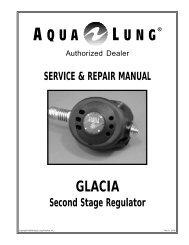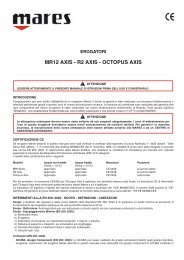MR12 PROTON - V16 PROTON - PROTON XL ... - Frogkick.dk
MR12 PROTON - V16 PROTON - PROTON XL ... - Frogkick.dk
MR12 PROTON - V16 PROTON - PROTON XL ... - Frogkick.dk
- No tags were found...
You also want an ePaper? Increase the reach of your titles
YUMPU automatically turns print PDFs into web optimized ePapers that Google loves.
WARNINGAttempting to dive in cold water conditions (10°C or less) without adequate training may result in serious injury. Beforediving in cold water, it is advisable to take a special training course under the supervision of a certified diving instructor.Because no regulator can be completely guaranteed against freezing of the second stage under all conditions, even Maresregulators fitted with the CWD kit may be subject to "icing" phenomena which can interfere with their correct operation.This may result in serious injury. Therefore, to minimize the potential hazards, it is essential to be adequately trained in theprevention and handling of the problems which may arise from a regulator subject to "icing" phenomena.Particularly in these situations, the following precautions should be observed:1) Avoid breathing through the regulator when out of the water.2) Only press the purge valve underwater, and even then very gently and for brief periods.- The Proton Octopus second stage can only be used with the <strong>MR12</strong>, <strong>V16</strong> and V32 first stages or with certified Mares regulators. WARNINGFor safety reasons, it is not advisable to use an Octopus second stage that is not a certified Mares Octopus. Themanufacturer declines responsibility for damages to persons or property resulting from the use of different Octopussecond stages. The MARES Octopus second stages have been designed and tested for use on first stage low pressureports OTHER than the preferential port used for the primary second stage. An Octopus second stage MAY NOT besubstituted for a primary second stage, and must in no circumstances be connected to the preferential low pressure portintended for the primary second stage. WARNINGFor safety reasons, the submersible pressure gauge / high pressure safety device that is assembled on the regulator mustcomply with the EN 250: 2000 standard. According to this regulation, with an upstream pressure of 100 bar the maximumpermitted airflow through the connector toward the first stage must not exceed 100 liters/min. If you have a submersiblepressure gauge / high pressure safety device that complies with the EN 250: 1993 standard or a different specification,check whether the instruction manual indicates the value of the maximum airflow.The use of submersible pressure gauges / safety devices that do not comply with the EN 250: 2000 standard, or which donot have an indication of the maximum permitted airflow through the first stage connector may result in serious accidents.GENERAL WORKING PRINCIPLERegulators reduce cylinder pressure, referred to as inlet pressure, to a pressure suitable for breathing. Modern regulators do this in twostages connected by a hose. The first stage provides pressure to the second stage; this reduced pressure remains constant despite thesizeable changes undergone by the cylinder inlet pressure during the dive (dropping from 3000/4350 to few hundred psi). The secondstage brings pressure down to ambient pressure and delivers air only when the diver inhales. Each stage of the regulator contains aninternal valve. When the diver inhales, the pressure inside the case is lowered and a pressure differential (imbalance) is created across thediaphragm (beginning of inhalation). The response of the diaphragm is to bend inward, contact the lever and open the second stage valve.Air continues to flow into the case until the pressure balance is regained (end of inhalation).FIRST STAGEFor the second stage to work properly, the first stage must deliver air at a correct and - most importantly - constant intermediate pressure.This characteristic, provided by all Mares first stages, is essential for obtaining optimal adjustment of the second stage and ensuring topperformance for the entire duration of the dive, regardless of tank pressure.All Mares first stages are available with the following types of tank valve fittings: DIN 477/13 screw (max pressure 200 bar), DIN 477/50 screw(max pressure 300 bar), international YOKE CGA 850 adapter (max pressure 232 bar), in accordance with the EN 250: 2000 standard.SECOND STAGEThe purpose of the second stage is to deliver air at ambient pressure, only during the inhalation phase. The diagram of a second stageshown in Fig. 6 illustrates its operation. When the diver inhales, the pressure inside the second stage decreases, creating a pressuredifference (imbalance) between the two sides of the diaphragm. This pulls the flexible diaphragm inward, pressing the demand lever andunseating the second stage valve. This opening allows air to flow in through the second stage and to the diver, until the diver stopsinhaling. At this point the internal 2nd stage pressure increases, pushing the diaphragm back in the opposite direction, causing the valve toreturn to its seat and shutting off the airflow.<strong>MR12</strong> First stage (Fig. 2)The historic tried-and-tested first stage.A diaphragm design featuring the DFC (Dynamic Flow Control) system for dynamically balancing the pressure drop during the inhalation phase.Replaceable high-pressure valve seat in corrosion-proof metal. Chrome and nickel-plated body protected by a shockproof elastomer cover. FourLP low-pressure ports and two HP ports for connecting a pressure gauge or the transmitting unit of an air integrated computer.<strong>V16</strong> First stage (Fig. 3)Mares <strong>V16</strong> First stage is the latest version of the balanced diaphragm regulator. In addition to all the characteristics that have made thesuccess of this Mares product, including the DFC system, the <strong>V16</strong> is equipped with the now famous SCS (Spherical Core Seal) valve forlonger life. The poppet shuts off the flow of air by means of a highly durable metal hemisphere, which is unassailable by oils or grease. Thevalve seat is made from a special high strength technopolymer. Two HP ports and four LP ports, pre-positioned for rational hose routing.The shock and scratch-resistant black coating is unique and makes the <strong>V16</strong> the perfect companion for hundreds of dives.8



